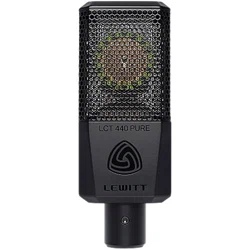Loading ...
Loading ...
Loading ...

5
Example: if a microphone has an equivalent noise level (self-noise) of 10 dB (A)
SPL and picks up a sound source with 10 dB (A) SPL the signal to noise ratio is
1:1 or 50/50.
The range between the equivalent noise level and the maximum sound pressure
level is referred to as the dynamic range of a microphone.
Spoken in practical terms, low self-noise does not limit your freedom of
microphone positioning. With noisy microphones, you need to get very close to
the recorded sound source to get a good signal-to-noise ratio. A low self-noise
microphone, on the other hand, can record not only distant but also very quiet
sound sources. With its 7 dB (A) of equivalent noise level it is guaranteed that
your studio microphone is never the cause of noise problems.
// Frequency response
The frequency response shows the sensitivity over the microphone’s frequency
spectrum and has a huge inuence on the “sound” of a microphone. See section
9 Tech graph for the frequency response chart.
// MAX SPL
LCT 440 PURE - Max. SPL for 0.5 % THD: 140 dBSPL
Manufacturers state the maximum sound pressure level a microphone can
handle before the signal starts to distort. In sound reproduction, we often aim for
a “pure”, undistorted signal. When distortion becomes audible, depends on the
source material and the listener’s perception. Most manufacturers state the MAX
SPL at 0.5% THD (Total Harmonic Distortion), measured at 1kHz.
4.4. Important specs of a condenser microphone
// Sensitivity
LCT 440 PURE - Sensitivity: 27.4 mV/Pa, -31.2 dBV/Pa
You can often read that a condenser microphone has a “high” sensitivity. What
does that mean in practical terms? In short, it means that a more sensitive
microphone is “hotter” – i.e. it requires less gain (amplication) to achieve
a certain output level. You can specify a microphone’s sensitivity in two ways:
in mV/Pa or dBV/Pa.
“27.4 mV/Pa” means, the microphone produces an output signal of 27.4 mV
when it is being exposed to 1 Pascal (1Pa = 94 dB SPL). “-31.2 dBV/Pa“ means,
the microphone produces an output signal of -32.7 dBV when it is being exposed
to 1 Pascal (1Pa = 94 dB SPL). This value is more practical, as dB values are easily
comparable.
LCT 440 PURE: -31.2 dBV/Pa.
Microphone X: -51.2 dBV/Pa. Microphone X would need an extra gain of 20 dB to
produce the same output level as the LCT 440 PURE.
// Equivalent noise level or self-noise
LCT440 PURE - Equivalent noise level: 7 dB (A)
Self-noise or, more accurately, equivalent noise level is the sound pressure level
that is equal to the RMS voltage that can be measured at the output connector
of a microphone without an external sound source being recorded. In other
words, there is a sound pressure level that matches the inherent self-noise of the
microphone. This sound pressure level is the equivalent noise level (self-noise) of
the microphone.
Loading ...
Loading ...
Loading ...
